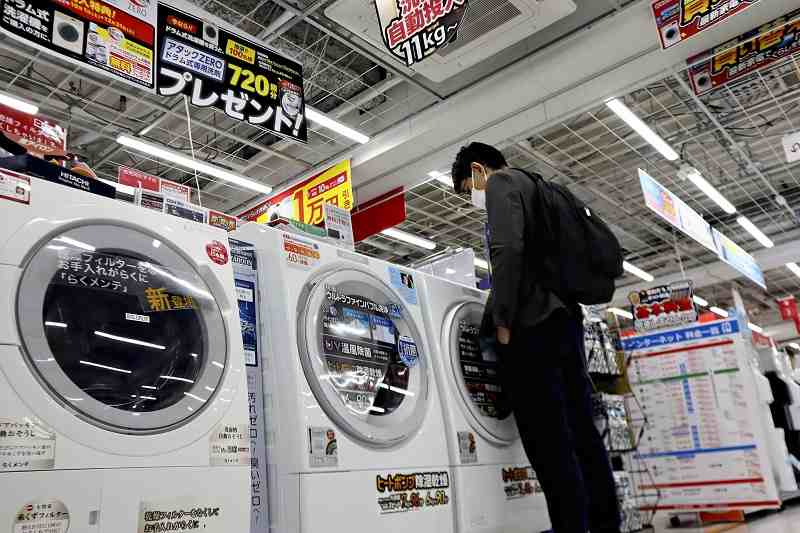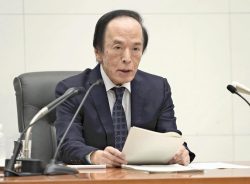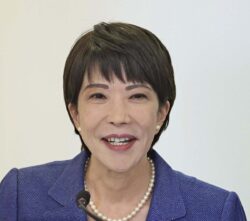
Washing machines are seen on display at an electronics retailer in Tokyo on Friday.
6:00 JST, October 23, 2022
In September, consumer prices soared by 3% for the first time in about 31 years, further accelerating the pace of price increases.
The government is mulling measures to temporarily reduce electricity bills, among other things, but measures to encourage companies to raise pay are also needed as households are bearing a heavier burden amid a surge in prices coupled with sluggish wage growth.
Bargain hunt
“The prices of cup noodles and precooked curry have gone up. To find the cheapest prices, I’ve been checking three stores in my neighborhood, including supermarkets and a discount store,” said a 46-year-old part-time employee in Chofu, western Tokyo.
One of the factors that pushed up consumer prices in September was an increase in food prices. Cup noodles, which used to cost around ¥80 yen each, now cost more than ¥100. The prices of bread have risen by 14.6% from a year earlier and deep-fried chicken by 11.3%.
Food manufacturers are raising the prices of products across the board as the prices of ingredients such as wheat have increased due to supply chain disruption and the weakening yen.
The sticker prices of products in home appliance stores have also risen considerably as major electronics companies have raised the prices of air conditioners and drum-type washing machines, among other products.
Increased material costs and the weak yen are likely to mean prices will continue to rise going forward. “The surge in prices of food products and other daily necessities has been accelerating,” said Takeshi Minami, a chief economist at Norinchukin Research Institute Co. Ltd. “Consumer prices may hit the mid-3% range this month.”
The government has decided to extend a one-off ¥50,000 handout for low-income households and a subsidy to keep gasoline prices down, among other measures, which will require huge amounts of financial resources.
Gasoline subsidies alone cost about ¥300 billion each month. How long these measures should be kept in place will likely be a point of discussion in the future.
Stagnant wage growth
In addition to temporary measures to ease the financial burden on households, measures to realize stable pay increases are also needed. On Thursday, the Japanese Trade Union Confederation (Rengo) revealed a plan to call for a pay increase of about 5% in next year’s spring labor talks.
However, Akio Mimura, chairman of the Japan Chamber of Commerce and Industry, indicated wage increases would not be easy for small and medium-sized companies facing a difficult business environment.
Conventionally, when the prices of goods rise, companies see their earnings rise, which should lead to higher wages for their workers.
However, many companies in Japan are cautious about raising pay because of the long period of deflation in the country. As a result, the government will also need to devise measures to support medium to long-term corporate growth that will lead to proactive pay increases.
"Business" POPULAR ARTICLE
-

Tokyo Economic Security Forum to Hold Inaugural Meeting Amid Tense Global Environment
-

Keidanren Chairman Yoshinobu Tsutsui Visits Kashiwazaki-Kariwa Nuclear Power Plant; Inspects New Emergency Safety System
-

Imports of Rare Earths from China Facing Delays, May Be Caused by Deterioration of Japan-China Relations
-

University of Tokyo Professor Discusses Japanese Economic Security in Interview Ahead of Forum
-

Japan Pulls out of Vietnam Nuclear Project, Complicating Hanoi’s Power Plans
JN ACCESS RANKING
-

Tokyo Economic Security Forum to Hold Inaugural Meeting Amid Tense Global Environment
-

Keidanren Chairman Yoshinobu Tsutsui Visits Kashiwazaki-Kariwa Nuclear Power Plant; Inspects New Emergency Safety System
-

Imports of Rare Earths from China Facing Delays, May Be Caused by Deterioration of Japan-China Relations
-

University of Tokyo Professor Discusses Japanese Economic Security in Interview Ahead of Forum
-

Japan Pulls out of Vietnam Nuclear Project, Complicating Hanoi’s Power Plans

























